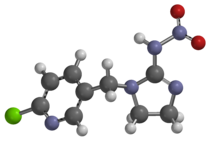
| |

| |
| Names | |
|---|---|
| IUPAC name
N-{1-[(6-Chloro-3-pyridyl)methyl]-4,5-dihydroimidazol-2-yl}nitramide
| |
| Identifiers | |
3D model (JSmol)
|
|
| ChEBI | |
| ChEMBL | |
| ChemSpider | |
| DrugBank | |
| ECHA InfoCard | 100.102.643 |
| KEGG | |
PubChem CID
|
|
| UNII | |
CompTox Dashboard (EPA)
|
|
| |
| |
| Properties | |
| C9H10ClN5O2 | |
| Molar mass | 255.661 |
| Appearance | Colorless crystals |
| Melting point | 136.4 to 143.8 °C (277.5 to 290.8 °F; 409.5 to 416.9 K) |
| 0.51 g/L (20 °C) | |
| Pharmacology | |
| QP53AX17 (WHO) | |
| Legal status | |
Except where otherwise noted, data are given for materials in their standard state (at 25 °C [77 °F], 100 kPa).
| |
Imidacloprid is a systemic insecticide belonging to a class of chemicals called the neonicotinoids which act on the central nervous system of insects. The chemical works by interfering with the transmission of stimuli in the insect nervous system. Specifically, it causes a blockage of the nicotinergic neuronal pathway. By blocking nicotinic acetylcholine receptors, imidacloprid prevents acetylcholine from transmitting impulses between nerves, resulting in the insect's paralysis and eventual death. It is effective on contact and via stomach action.[1] Because imidacloprid binds much more strongly to insect neuron receptors than to mammal neuron receptors, this insecticide is more toxic to insects than to mammals.[3]
From 1999[4] through at least 2018[update],[5][6] imidacloprid was the most widely used insecticide in the world. Although it is now off patent, the primary manufacturer of this chemical is Bayer CropScience (part of Bayer AG). It is sold under many names for many uses; it can be applied by soil injection, tree injection, application to the skin of the plant, broadcast foliar, or ground application as a granular or liquid formulation, or as a pesticide-coated seed treatment.[7][3][8] Imidacloprid is widely used for pest control in agriculture. Other uses include application to foundations to prevent termite damage, pest control for gardens and turf, treatment of domestic pets to control fleas,[3] protection of trees from boring insects,[9] and in preservative treatment of some types of lumber products.[10]
A 2018 review by the European Food Safety Authority (EFSA) concluded that most uses of neonicotinoid pesticides such as Imidacloprid represent a risk to wild bees and honeybees.[11][12] In 2022 the United States Environmental Protection Agency (EPA) concluded that Imidacloprid is likely to adversely affect 79 percent of federally listed endangered or threatened species and 83 percent of critical habitats.[13] The pesticide has been banned for all outdoor use in the entire European Union since 2018, but has a partial approval in the United States and some other countries. It still remains in widespread use in other major parts of the world.[14][15]
- ^ a b "Pesticide Information Profiles: Imidacloprid Breaz". Extension Toxicology Network. Retrieved April 7, 2012.
- ^ "Health product highlights 2021: Annexes of products approved in 2021". Health Canada. 3 August 2022. Retrieved 25 March 2024.
- ^ a b c Gervais et al. 2010.
- ^ Yamamoto, Izuru (1999). "Nicotine to Nicotinoids: 1962 to 1997". In Yamamoto, Izuru; Casida, John (eds.). Nicotinoid Insecticides and the Nicotinic Acetylcholine Receptor. Tokyo: Springer-Verlag. pp. 3–27.
- ^ Casida, John E. (2018-01-07). "Neonicotinoids and Other Insect Nicotinic Receptor Competitive Modulators: Progress and Prospects". Annual Review of Entomology. 63 (1). Annual Reviews: 125–144. doi:10.1146/annurev-ento-020117-043042. ISSN 0066-4170. PMID 29324040.
- ^ Ihara, Makoto; Matsuda, Kazuhiko (2018). "Neonicotinoids: molecular mechanisms of action, insights into resistance and impact on pollinators". Current Opinion in Insect Science. 30. Elsevier: 86–92. doi:10.1016/j.cois.2018.09.009. ISSN 2214-5745. PMID 30553491. S2CID 58767188.
- ^ "Imidacloprid: Human Health and Ecological Risk Assessment. Final Report" (PDF). USDA Forest Service. 2005. Archived from the original (PDF) on May 13, 2021. Retrieved July 23, 2021.
- ^ "Bayer seedgrowth". Bayer SeedGrowth. Archived from the original on January 17, 2021. Retrieved April 11, 2021.
- ^ Herms DA, McCullough DG, Smitley DR, Sadof C, Williamson RC, Nixon PL (2009). "Insecticide options for protecting ash trees from emerald ash borer" (PDF). North Central IPM Center Bulletin. Archived from the original (PDF) on January 26, 2016. Retrieved April 7, 2012.
- ^ International Code Council Evaluation Service Report ESR-1851, dated August 2011. Archived 2018-12-12 at the Wayback Machine
- ^ "Neonicotinoids: risks to bees confirmed | EFSA". www.efsa.europa.eu. 2018-02-28. Retrieved 2023-06-23.
- ^ "Conclusion on the peer review of the pesticide risk assessment for bees for the active substance clothianidin". EFSA Journal. 11: 3066. 2013. doi:10.2903/j.efsa.2013.3066.
- ^ US EPA, OCSPP (2022-06-16). "EPA Finalizes Biological Evaluations Assessing Potential Effects of Three Neonicotinoid Pesticides on Endangered Species". www.epa.gov. Retrieved 2023-06-23.
- ^ Carrington, Damian (2018-04-27). "EU agrees total ban on bee-harming pesticides". The Guardian. ISSN 0261-3077. Retrieved 2023-06-23.
- ^ Milman, Oliver (2022-03-08). "Fears for bees as US set to extend use of toxic pesticides that paralyse insects". The Guardian. ISSN 0261-3077. Retrieved 2023-06-23.